Streamlining the Art of Needlework Digitizing: Step-by-Step Guide
As modern technology continues to advancement, the digitization process has ended up being much more accessible, enabling lovers to bring their detailed layouts to life with simplicity. In this overview, we will unravel the complexities of embroidery digitizing, damaging down each step systematically to enhance the procedure and equip both beginners and experienced embroiderers alike.
Comprehending Embroidery Digitizing Software
Needlework digitizing software program serves as an essential tool for transforming detailed layouts right into digital layouts suitable with embroidery devices, facilitating exact stitching and customization. This customized software allows users to import numerous image data formats, such as JPG or PNG, and transform them right into needlework machine-readable layouts like DST, EXP, or PES - Digitizing for Embroidery. By using functions like stitch editing and enhancing, rug alternatives, and string color option, digitizing software enables customers to control every aspect of the design process
In addition, progressed embroidery digitizing software program uses devices for developing complex styles, adjusting stitch thickness, and integrating elaborate information. Users can also preview the style prior to stitching it out, ensuring accuracy and decreasing errors. In addition, several software programs provide automated features that help improve the digitizing procedure, conserving effort and time.
Recognizing the capabilities of needlework digitizing software program is essential for accomplishing high-grade lead to needlework jobs. By grasping this tool, needlework fanatics and specialists can unleash their imagination and bring elaborate designs to life with precision and performance.

Choosing the Right Design Documents
After familiarizing yourself with the capabilities of needlework digitizing software program, the following critical action in the process is picking the appropriate style apply for your project. Digitizing for Embroidery. When picking a layout declare embroidery digitizing, it's essential to consider the intricacy of the layout, the dimension of the end product, and the type of material you will certainly be dealing with
For intricate styles with great details, a high-resolution picture or vector documents is suggested to make sure that the needlework maker can precisely duplicate the design. Furthermore, the dimension of the end product plays a substantial function in selecting the ideal style data. Larger layouts may need higher resolution data to keep clearness and sharpness.
Moreover, the kind of material you will be embroidering on influences the selection of style documents. Various textiles might require adjustments in the design data to guarantee that the stitches are correctly aligned and the style appears as intended. By very carefully selecting the best layout file based upon these elements, you can set on your own up for an effective embroidery digitizing procedure.
Digitizing Tools and Methods
Making use of specialized software application and accuracy techniques, digitizing tools are important in changing elaborate layouts into embroidery-ready documents. Needlework digitizing software, such as Wilcom, Hatch, or Embrilliance, gives the necessary system to transform artwork into stitch data. These programs offer features like stitch modifying, rug options, and lettering tools to ensure the layout equates perfectly onto textile.
One of the vital methods in digitizing is creating a clear path for the embroidery click for info device to comply with. This includes digitizing each aspect of the design with precision, figuring out stitch types, thickness, and directions. By utilizing tools like digitizing tablet computers or software-specific plugins, embroiderers can accomplish a high degree of accuracy in their digitized layouts.
In addition, grasping the art of padding sewing is critical for creating high quality embroidery. Underlay sewing supports the fabric and creates a structure for the design, guaranteeing that the final item is both visually attractive and lasting. By comprehending these digitizing devices and techniques, embroiderers can elevate their craft and bring detailed layouts to life with precision and effectiveness.
Personalizing Stitch Types and Instructions
The choice of stitch kinds can substantially influence the general appearance and appearance her explanation of the embroidered design. By tactically combining these stitch kinds, embroiderers can achieve deepness and dimension in their designs.
Additionally, the instructions of stitches plays a crucial role in boosting the visual allure of the last needlework. By exploring with different stitch angles and patterns, embroiderers can bring their designs to life with exceptional information and ins and out.
Screening and Refining Your Digitized Design
To make certain the precision and top quality of your digitized layout, thorough testing and refinement are essential action in the needlework digitizing procedure. As soon as you have finished the digitization of your design, it is critical to test it before proceeding with the actual needlework. Evaluating permits you to recognize any possible problems such as string breaks, stitch thickness problems, or style distortions that might influence the final result.

After testing, it is important to fine-tune your digitized style based on the comments from the test sew-out. This might involve tweaking sew settings, readjusting densities, or making adjustments to the general style to achieve the wanted outcome. By iterating with testing and refinement, you can tweak your digitized layout to excellence before moving on with the actual needlework process.
Conclusion
In verdict, understanding the art of embroidery digitizing calls for an extensive understanding of the look these up software program, picking the best layout file, making use of digitizing devices and strategies, personalizing stitch types and instructions, and testing and improving the digitized design. By following these actions, embroiderers can simplify the digitizing procedure and develop premium stitched designs with accuracy and effectiveness.